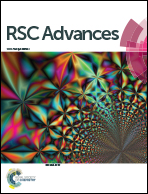Hydrolytically active tetranuclear [NiII2]2 complexes: synthesis, structure, spectroscopy and phosphoester hydrolysis†
Abstract
Three tetranuclear nickel(II) complexes, [Ni4(H2chdp)2(H2O)4]Br2·4CH3OH·3H2O (1), [Ni4(H2chdp)2(H2O)4](PF6)2 (2) and [Ni4(H2chdp)2(H2O)4](ClO4)2·3.2CH3OH·0.8H2O (3) have been synthesized by exploiting the flexibility, chelating ability and bridging potential of a new symmetrical μ-bis(tetradentate) ligand, H5chdp (H5chdp = N,N′-bis[2-carboxybenzomethyl]-N,N′-bis[2-hydroxyethyl]-1,3-diaminopropan-2-ol). Complexes 1, 2 and 3 have been synthesized by carrying out reaction of the ligand H5chdp with stoichiometric amounts of NiCl2·6H2O/NaBr, NiCl2·6H2O/NH4PF6, and Ni(ClO4)2·6H2O, respectively, in methanol–water in the presence of NaOH at ambient temperature. Characterizations of the complexes have been done using various analytical techniques including single crystal X-ray structure determination of complexes 1 and 3. Molecular architecture of each complex is built from the self-assembly of two monocationic [Ni2(H2chdp)(H2O)2]+ units which are exclusively bridged by two benzoate functionalities of the ligands. Single crystal X-ray structure analyses reveal that the metallic cores of complexes 1 and 3 consist of four distorted octahedral nickel(II) ions with intra-ligand Ni⋯Ni separation of 3.527(7) Å and 3.507(1) Å, respectively. Complexes 1 and 3 display a rare μ3:η2:η1:η1 bridging mode of two benzoate groups of H2chdp3− ligand with each bridging among three nickel(II) ions. Mass spectrometric analyses suggest that all the tetranuclear complexes are stable in solution. Potentiometric titration results and the corresponding species distribution curves show that all the complexes exist predominantly in their tetrameric species in solution, in the pH range of 6–12. The catalytic activity of all the three complexes toward phosphoester hydrolysis has been investigated in methanol–water (1 : 1; v/v) solution by UV-vis spectrophotometric technique using bis(p-nitrophenyl)phosphate (BNPP) as a model substrate.
![Graphical abstract: Hydrolytically active tetranuclear [NiII2]2 complexes: synthesis, structure, spectroscopy and phosphoester hydrolysis](/en/Image/Get?imageInfo.ImageType=GA&imageInfo.ImageIdentifier.ManuscriptID=C5RA16555E&imageInfo.ImageIdentifier.Year=2015)

 Please wait while we load your content...
Please wait while we load your content...